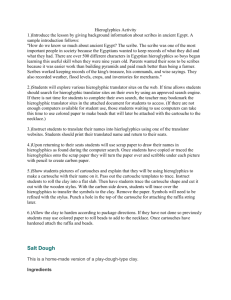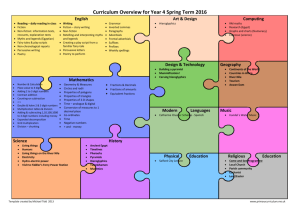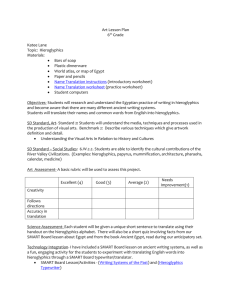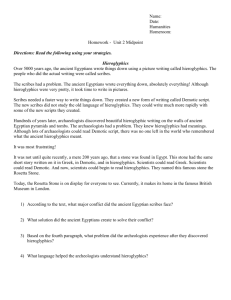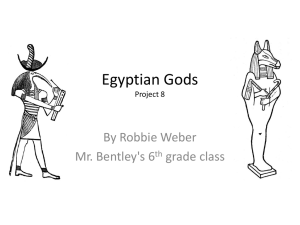Formal 3 - Heirogliphics
advertisement
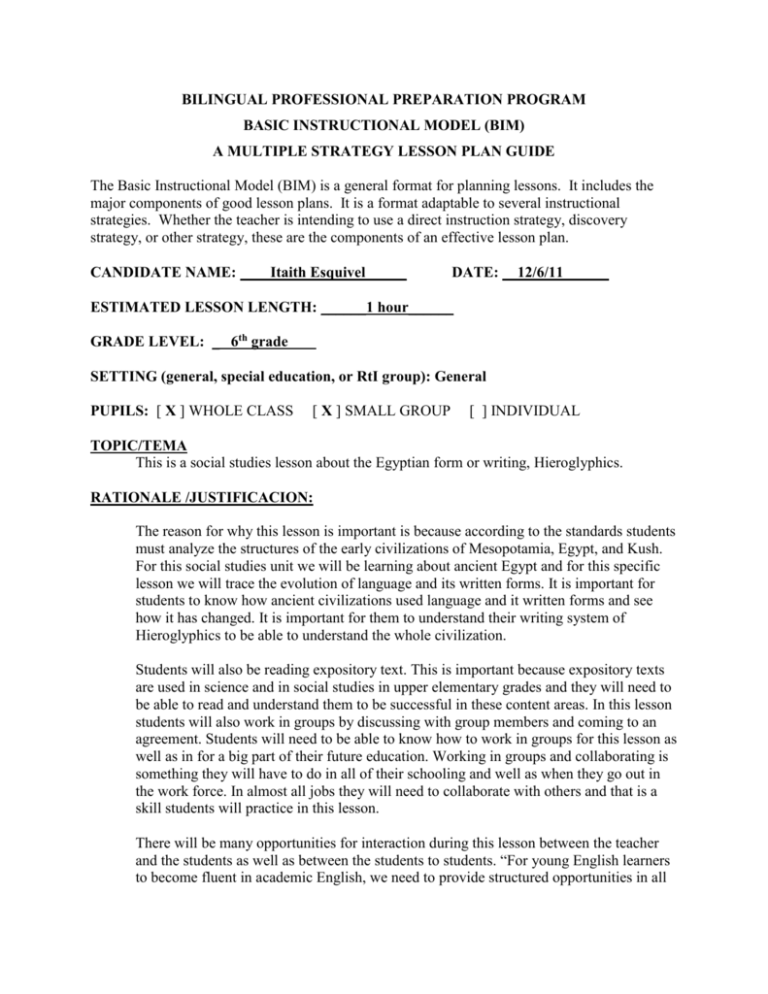
BILINGUAL PROFESSIONAL PREPARATION PROGRAM BASIC INSTRUCTIONAL MODEL (BIM) A MULTIPLE STRATEGY LESSON PLAN GUIDE The Basic Instructional Model (BIM) is a general format for planning lessons. It includes the major components of good lesson plans. It is a format adaptable to several instructional strategies. Whether the teacher is intending to use a direct instruction strategy, discovery strategy, or other strategy, these are the components of an effective lesson plan. CANDIDATE NAME: ____Itaith Esquivel _____ DATE: __12/6/11______ ESTIMATED LESSON LENGTH: ______1 hour______ GRADE LEVEL: _ 6th grade SETTING (general, special education, or RtI group): General PUPILS: [ X ] WHOLE CLASS [ X ] SMALL GROUP [ ] INDIVIDUAL TOPIC/TEMA This is a social studies lesson about the Egyptian form or writing, Hieroglyphics. RATIONALE /JUSTIFICACION: The reason for why this lesson is important is because according to the standards students must analyze the structures of the early civilizations of Mesopotamia, Egypt, and Kush. For this social studies unit we will be learning about ancient Egypt and for this specific lesson we will trace the evolution of language and its written forms. It is important for students to know how ancient civilizations used language and it written forms and see how it has changed. It is important for them to understand their writing system of Hieroglyphics to be able to understand the whole civilization. Students will also be reading expository text. This is important because expository texts are used in science and in social studies in upper elementary grades and they will need to be able to read and understand them to be successful in these content areas. In this lesson students will also work in groups by discussing with group members and coming to an agreement. Students will need to be able to know how to work in groups for this lesson as well as in for a big part of their future education. Working in groups and collaborating is something they will have to do in all of their schooling and well as when they go out in the work force. In almost all jobs they will need to collaborate with others and that is a skill students will practice in this lesson. There will be many opportunities for interaction during this lesson between the teacher and the students as well as between the students to students. “For young English learners to become fluent in academic English, we need to provide structured opportunities in all subject areas to practice using the language” (Echevarria, Vogt, Short. 2010, p. 119). There are opportunities for rich discussion in this lesson that will reaffirm the content as well as the content vocabulary for this lesson. Students will also work with partners on extracting the important information in their assigned reading and from there they will collaborate in choosing what they will share with the class. Having students interact like this helps EL students collaborate with Standard English and the participation challenges them to use academic language. This lesson provides opportunities for students to use learning strategies such as cognitive strategies because they have to organize their own learning in their groups. Students have to be able to first organize their thought and collaborate with a group and share their understandings. This lesson is scaffolded for all students in that first they learn about the Egyptian writing system and Hieroglyphics before they are expected to translate their name using the Hieroglyphic alphabet. The teacher will strategically group the students. The EL students and the students with special need will really benefit from this strategic grouping because they will be placed in groups were they can be encouraged to participate and for the EL use academic language. The EL students in this class are in the intermediate proficiency level, so they often do not need first language clarification. What they need is for the teacher to encourage them to expand their vocabulary, and their application of more elaborate grammatical structures. I believe with this lesson they are able to do this and it will help them in their language development. CONTENT STANDARD/ ESTANDAR DEL CONTENIDO CA 6.2 Students analyze the geographic, political, economic, religious, and social structures of the early civilizations of Mesopotamia, Egypt, and Kush. 9. Trace the evolution of language and its written forms. CA 6.2.0 – Reads and understands grade level text ACADEMIC LANGUAGE DEMAND To identify academic language demand Determine key concept vocabulary and other essential words Content Vocabulary Hieroglyphics (Hieroglyphs) Scribes Reed plant Literate Demotic writing Cartouche Other Vocabulary Papyrus Picture symbols Hieroglyphic alphabet Determine the content process skills/tasks Discuss Describe Translate Make Language skills: listening, speaking, reading, writing Listening Skills: Students will be placed into strategic groups assigned by the teacher and they will listen to their partners read their assigned reading together. They will discuss and listen to what other classmates think is the most important information in their assigned readings and choose what they will share with the class. Students will listen to other classmate’s ideas during group presentations. Students will listen to the teacher give direct instruction on the Egyptian alphabet. Students will also use their listening skills in listening to the teacher’s directions of the lesson. Speaking Skills: Students will use their speaking skills by first reading out-loud their assigned reading. They will also discuss their assigned topics with their group members. They then will speak to other classmates about their assigned topics and discuss the different aspects of Hieroglyphics. Students will then be asked to speak in a group presentation to the whole class about their assigned topics. Students will then have the opportunity to share their cartouches they make with the class at the end of the lesson. Reading Skills: Students will practice on their reading skills when they read their assigned reading with their group members. Students will read some of the most important information to the class during their group presentation. Students will also read the Hieroglyphic alphabet and translate their name from English into Hieroglyphics. Writing Skills: Students will use their writing skills when they have to highlight the important information in their assigned reading that they will have to share with the class. They will also have to translate their name into hieroglyphics and write them on their cartouche (name plate). Language functions: what is purpose of language in the lesson Describe Translate Language forms: language patterns and grammatical structures students will be using Using appropriate vocabulary Using complete sentences Using proper grammar ELD STANDARD/ ESTANDAR DE INGLES COMO SEGUNDO IDIOMA Grade: 6-8th Proficiency level: Intermediate Domain: Reading Strand: Fluency and Systematic Vocabulary Development Decodes for automaticity: reads grade appropriate narrative and expository texts aloud with appropriate pacing, intonation, and expression. Grade: 6th Proficiency level: Intermediate Domain: Listening and Speaking Strand: Strategies and Application Uses Standard English when speaking; varies way of speaking: He understood when speaking, using consistent Standard English grammatical forms and sounds; however, some rules may not be in evidence (e.g., third person singular, male and female pronouns). STRATEGIES/TECHNIQUES TO SUPPORT ACADEMIC LANGUAGE DEVELOPMENT: Highlight important information in expository text Jigsaw expository text Modeling Group work Vocabulary word wall UNIVERSAL ACCESS The directions for this lesson will be given in concise segments and in a level of language proficiency that the EL will be able to comprehend. Students will be strategically grouped by the teacher so that EL students will work with students who will expose them to proper English. For our English Learners who are at the intermediate proficiency level we will encourage them to expand their vocabulary, and their application or more elaborate grammatical structures. The two students with special need will also be strategically grouped with students who will clarify instruction and be kind to help them if they need it. As a teacher we will also encourage participation in the collaborative group activity. OBJECTIVE(S)/ OBJETIVO: (Content and Language) Content Objective: After a collaborative activity, students will be able to describe one aspect of Egyptian hieroglyphics in a group presentation. After direct instruction on the Egyptian alphabet, students will be able to translate their name into Egyptian Hieroglyphics onto a cartouche. Language Objective: Students will discuss, choose, and describe one aspect of Egyptian Hieroglyphics in a group presentation appropriate vocabulary and correct grammar. Students will translate their name into Egyptian Hieroglyphics and illustrate them on a cartouche they will make. ASSESSMENT(S)/EVALUACION The first form of assessment will be done when students are working in their groups with their assigned reading. I will assess if they are working well in their group and participating by walking around the room and observing. The second form of assessment will be an assessment of the group presentations. This assessment will show what the students have learned from their assigned reading and if they were able to extract the most important information which is a content objective. The assessment that I will use for the presentation will be more of a formative assessment because they are reading expository text. There will also be an assessment of whether students were able to translate their name into Hieroglyphics using the direct instruction given by the teacher and also the Hieroglyphic alphabet. They will do this assessment task on a cartouche (name plate) they will also make. REQUIRED TEACHER BACKGROUND INFORMATION: The teacher must have read and be familiar with the Hieroglyphic reading. The teacher must have strategically grouped the students before the lesson so that there is maximum participation and learning from EL students as well as from the students with special needs. The teacher must be familiar with the Hieroglyphic alphabet and have an example of a cartouche (name plate). TASK ANALYSIS: Students must be familiar with working and reading in groups. PROCEDURES/ PROCEDIMIENTO: Introduction/Introducción 1. I will start this lesson by posting and letting the student know what the objectives of the lesson are going to be. I will explain to them that we are going to learn about the ancient Egyptian writing system of Hieroglyphics. I will explain that they are going to get an information sheet that talks about Hieroglyphics. The activity is that they will be working in their nomes (Egyptian city) that they sit by and they are going to work together by first reading all of the information. Each nome (group) will be responsible for analyzing a section of reading and they will discuss in their groups and choose the information that is the most important. They will highlight what they think is most important to share with the whole class in a small presentation. 2. Before they start reading the information sheet I will talk about some of the new vocabulary they are going to see in this lesson and write them on the board. I will discuss them with the class so that when they come to them, they know what they mean. Activity Sequence/ Secuencia de actividades 1. I will then pass out the information sheet appropriate to each group. I will have the information sheets marked which section belongs to what group before the lesson, so that each group knows exactly what section they are doing. 2. During the time that they are reading and discussing with their groups, I will be walking around the classroom observing their participation as well as their collaboration. I will also help them if they have any questions on the vocabulary or content. I will be giving the students time frames by when they should have thing done. I will give them about 10 minutes to read all the information as a group. I will remind them to stay focused because they will have to do a presentation in a few minutes. 3. We will then start presentations. I will have each group stand up and face the students. They will each give their short presentation. 4. After the presentations, I will explicitly teach about the Hieroglyphics alphabet. I will give a short lesson and then I will explain what a cartouche is. I will explain the directions to their next activity of making a cartouche and translating their name into Hieroglyphics. I will show them my example of a cartouche I made with my name as an example. Closure/Clausura 1. When most of the students are finished they will have the opportunity to share their cartouches with their neighbors and talk about what their favorite aspect of learning about ancient Egyptian hieroglyphics was. 2. At the end of the lesson I will also go over the objectives with the students to see if they were met. MATERIALS/ MATERIALES: Copies of the Hieroglyphics readings and each group’s section marked appropriately Copies of the Hieroglyphics alphabet Copies of the cartouche template and construction paper PERSONAL TEACHING OBJECTIVES: My teaching objective for this lesson is that I give proper wait time and give students enough time to work in their groups, but that I also need to give them time limit frames. I need to give them a time limit for where they should be so that it keeps them on task. ASSESSMENT OF PERSONAL TEACHING OBJECTIVES The assessment for this objective will be that students are ready for their presentations when I tell them their time is up. If the students are ready on time and if they have the appropriate information, then I will know I had good time management and gave appropriate time frames.
